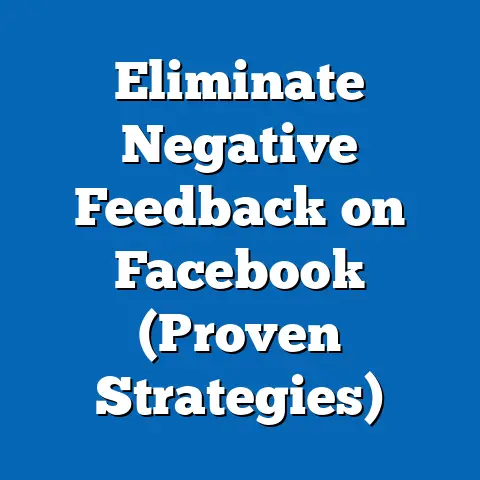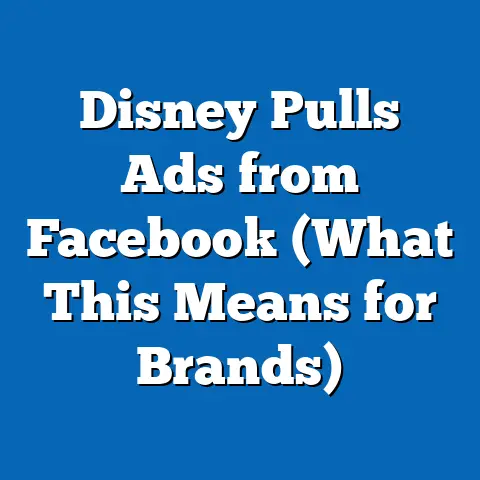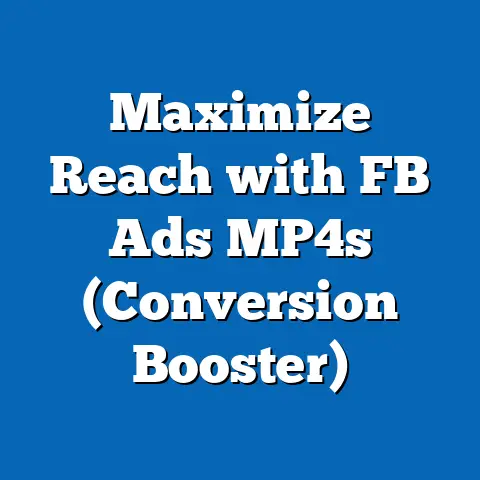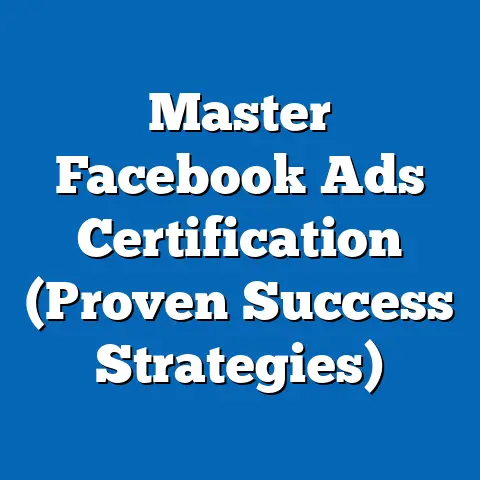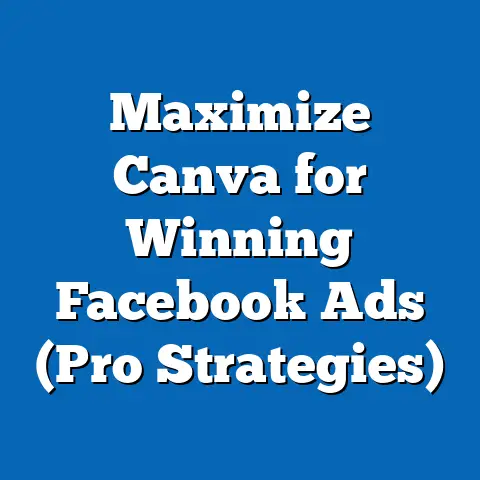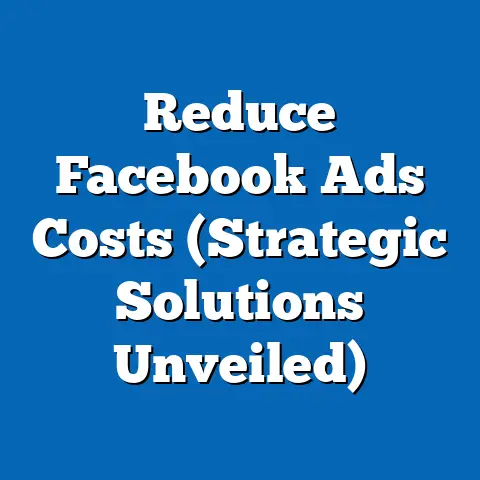Master Facebook Ads Image Templates (Proven Strategies)
In a world where complexity reigns supreme, it’s almost comical that the secret to successful Facebook ads can often be boiled down to just a handful of image templates. I’ve seen firsthand how a well-chosen, expertly crafted image can stop a user’s scroll and transform a casual browser into a paying customer. It’s not just about pretty pictures; it’s about strategically using visuals to communicate your message, connect with your audience, and drive results. Forget the endless scroll of confusing advice – I’m going to show you the proven image templates that actually work for Facebook ads.
The Importance of Visuals in Facebook Advertising
Let’s face it: we live in a visual world. Our brains are wired to process images faster than text, making visuals the gatekeepers of attention in the crowded digital landscape. Facebook is no exception. Users are bombarded with content every second, and your ad is fighting for a sliver of their attention. That’s where the power of visuals comes in.
Images in Facebook ads aren’t just decorative; they’re the first impression, the hook, and the emotional connector. A compelling image can:
- Capture attention: A vibrant, intriguing image instantly stands out in the newsfeed.
- Convey your message: Visuals can communicate complex ideas and emotions quickly and effectively.
- Build brand recognition: Consistent use of visual elements reinforces your brand identity.
- Drive engagement: Eye-catching images encourage likes, shares, and comments.
- Increase conversions: A well-chosen image can persuade users to click and take action.
Consider these statistics:
- Facebook posts with images see 2.3X more engagement than those without (BuzzSumo).
- Visual content is 40X more likely to get shared on social media than other types of content (HubSpot).
- Articles with an image once every 75-100 words received double the social media shares as articles with fewer images (BuzzSumo).
These numbers speak for themselves. Visuals are the fuel that drives successful Facebook advertising.
I’ve personally witnessed this power time and again. I remember working with a local bakery that struggled to get traction with their Facebook ads. Their initial ads were text-heavy and featured generic stock photos. After switching to high-quality images of their freshly baked goods, sales skyrocketed. The key was showcasing the visual appeal of their products, something text alone couldn’t achieve.
But it’s not just about having any image. It’s about having the right image. This involves understanding the psychology behind why certain images resonate with audiences. Color theory plays a role – warm colors like red and orange evoke excitement, while cool colors like blue and green convey trust and calmness. Emotional appeal is crucial – images that evoke joy, nostalgia, or even a hint of fear can be incredibly effective. And of course, brand consistency is paramount – your images should align with your brand’s overall aesthetic and messaging.
Key Takeaway: Visuals are essential for capturing attention, conveying your message, and driving results in Facebook advertising. Understanding the psychology behind effective images is key to creating ads that resonate with your audience.
Understanding Facebook Ads Image Specifications
Before you dive into creating stunning visuals, you need to understand Facebook’s image specifications. Ignoring these requirements can lead to poor ad performance, wasted ad spend, and even ad rejection.
Here’s a breakdown of the key specifications:
- Image Dimensions: Different ad placements require different image dimensions. For example, a single image ad in the Facebook newsfeed typically requires an image of at least 1080 x 1080 pixels. Carousel ads, on the other hand, can use images with dimensions of 1080 x 1080 pixels or 1080 x 1350 pixels.
- File Types: Facebook supports JPG and PNG file formats. JPGs are generally smaller in file size, making them ideal for images with lots of colors, while PNGs are better for images with text or graphics that require crisp lines.
- Aspect Ratios: Aspect ratio refers to the relationship between an image’s width and height. Different ad placements have different aspect ratio requirements. For example, a square image has an aspect ratio of 1:1, while a vertical image has an aspect ratio of 4:5 or 9:16.
- Text Overlay: Facebook has a “text overlay” policy that limits the amount of text that can be included in an image. Ideally, your image should have less than 20% text. Facebook provides a text overlay tool to help you check your images before uploading them.
Adhering to these specifications is crucial for several reasons:
- Optimal Display: Using the correct dimensions and aspect ratios ensures that your images are displayed properly across different devices and placements.
- Improved Performance: Images that meet Facebook’s specifications are more likely to be approved and perform well.
- Enhanced User Experience: Properly sized and optimized images provide a better user experience, leading to higher engagement and conversion rates.
Given the prevalence of mobile users on Facebook, it’s also essential to optimize your images for mobile viewing. This means using high-resolution images that look sharp on smaller screens and ensuring that your text is legible on mobile devices.
I learned this the hard way when I was running a campaign for a clothing retailer. I used images that looked great on desktop but were blurry and pixelated on mobile. As a result, our mobile click-through rate was significantly lower than our desktop CTR. Once I optimized the images for mobile, our mobile CTR increased dramatically.
Key Takeaway: Understanding and adhering to Facebook’s image specifications is crucial for optimal ad performance and user experience. Optimize your images for mobile viewing to reach the majority of Facebook users.
Proven Image Template Strategies
Now that you understand the importance of visuals and the technical requirements, let’s dive into some proven image template strategies that can help you create effective Facebook ads. These templates are based on years of experience and data, and they’ve been shown to consistently deliver results across various industries.
3.1. The Bold Statement Template
This template is all about grabbing attention with a single, powerful statement or question. The goal is to provoke curiosity and entice users to learn more.
- How it works: Use a large, easy-to-read font to display a concise and impactful statement or question. The image itself should be visually appealing and relevant to the statement.
- Example: An ad for a weight loss program might feature an image of a person looking confident and healthy, with the statement “Tired of Feeling Tired?” in bold letters.
- Why it works: This template taps into users’ emotions and desires, prompting them to reflect on their own situation and consider the solution being offered.
I’ve seen this template work wonders for lead generation campaigns. By asking a thought-provoking question, you can filter out unqualified leads and attract users who are genuinely interested in your product or service.
3.2. The Before-and-After Template
This template is particularly effective for showcasing transformation and results. It visually demonstrates the impact of your product or service, making it easy for users to see the value you offer.
- How it works: Use a split-screen or side-by-side image to showcase the “before” and “after” states. The “before” image should depict the problem, while the “after” image should depict the solution.
- Example: An ad for a skincare product might feature an image of a person with acne on one side and clear skin on the other.
- Why it works: This template provides concrete evidence of your product’s effectiveness, building trust and credibility with potential customers.
I remember running a campaign for a local landscaping company using the before-and-after template. We featured images of overgrown, neglected lawns before their services and beautifully manicured lawns after their services. The campaign was a huge success, generating a flood of new leads and customers.
3.3. The Product-in-Use Template
This template showcases your product in action, creating relatability and desire. It allows users to visualize themselves using your product and experiencing its benefits.
- How it works: Feature an image of a person using your product in a real-life setting. The image should be visually appealing and highlight the product’s key features.
- Example: An ad for a coffee maker might feature an image of a person enjoying a cup of coffee in their kitchen.
- Why it works: This template makes your product tangible and relatable, increasing the likelihood that users will consider purchasing it.
I’ve found this template to be particularly effective for e-commerce businesses. By showing your product in use, you can create a sense of urgency and desire, driving sales and conversions.
3.4. The Lifestyle Template
This template connects your product or service to a desirable lifestyle or experience. It appeals to users’ aspirations and emotions, making them want to associate themselves with your brand.
- How it works: Feature an image that depicts a lifestyle or experience that your target audience aspires to. The image should subtly incorporate your product or service.
- Example: An ad for a travel agency might feature an image of a couple relaxing on a tropical beach.
- Why it works: This template taps into users’ desires and aspirations, creating a strong emotional connection with your brand.
I’ve seen this template work particularly well for luxury brands. By associating their products with a high-end lifestyle, they can attract affluent customers who are willing to pay a premium for quality and exclusivity.
Key Takeaway: These proven image templates can help you create effective Facebook ads that capture attention, convey your message, and drive results. Experiment with different templates to see what resonates best with your audience.
Crafting Compelling Copy to Complement Your Images
While visuals are crucial, they’re only half the battle. Compelling copy is essential for enhancing the impact of your images and driving conversions. The synergy between imagery and copy is what truly makes a Facebook ad successful.
Here are some guidelines for writing copy that complements your images:
- Headline: Your headline is the first thing users will read, so make it count. Use a concise and attention-grabbing headline that highlights the key benefit of your product or service.
- Description: Your description should provide more detail about your product or service, elaborating on the benefits mentioned in the headline. Use persuasive language and address your target audience’s pain points.
- Call to Action: Your call to action (CTA) tells users what you want them to do next. Use a clear and compelling CTA that encourages users to click and take action. Examples include “Shop Now,” “Learn More,” or “Sign Up Today.”
- Emotional Triggers: Tap into users’ emotions by using language that evokes feelings of joy, excitement, or even fear. Emotional triggers can be incredibly effective for driving engagement and conversions.
Consider these examples of successful Facebook ads that effectively combine strong visuals with engaging copy:
- Example 1: An ad for a language learning app features an image of a person confidently speaking a foreign language. The headline reads “Speak a New Language in 3 Weeks!” The description highlights the app’s easy-to-use interface and proven methodology. The CTA is “Start Learning Now.”
- Example 2: An ad for a fitness program features a before-and-after image of a person who has lost weight. The headline reads “Transform Your Body in 12 Weeks!” The description highlights the program’s personalized workout plans and nutritional guidance. The CTA is “Join Now.”
- Example 3: An ad for a travel agency features an image of a couple enjoying a romantic vacation. The headline reads “Escape to Paradise!” The description highlights the agency’s exclusive deals and personalized travel planning services. The CTA is “Book Your Trip Today.”
I’ve found that the best copy is clear, concise, and customer-centric. Focus on the benefits of your product or service, and address your target audience’s specific needs and desires.
Key Takeaway: Compelling copy is essential for enhancing the impact of your images and driving conversions. Use a clear headline, persuasive description, and compelling call to action to encourage users to click and take action.
A/B Testing and Iteration
Creating effective Facebook ads is an iterative process. What works for one audience may not work for another. That’s why A/B testing is crucial for optimizing your ad campaigns and maximizing your ROI.
A/B testing involves creating two or more versions of your ad, each with a different element that you want to test. For example, you might test different headlines, images, or CTAs. You then run the ads simultaneously and track their performance to see which version performs best.
Here’s how to set up A/B tests:
- Define your goal: What do you want to achieve with your A/B test? Do you want to increase click-through rates, conversions, or engagement?
- Identify the element to test: What element of your ad do you want to test? Choose one element at a time to ensure that you can accurately measure the impact of each change.
- Create variations: Create two or more versions of your ad, each with a different variation of the element you’re testing.
- Run the test: Run the ads simultaneously and track their performance.
- Analyze the results: Analyze the data to see which version performed best.
- Iterate: Based on the results of your A/B test, make changes to your ad and run another test.
Some metrics to track during A/B testing include:
- Click-through rate (CTR): The percentage of users who click on your ad.
- Conversion rate: The percentage of users who take the desired action after clicking on your ad.
- Cost per click (CPC): The amount you pay each time someone clicks on your ad.
- Cost per conversion (CPC): The amount you pay for each conversion.
I’ve seen businesses completely transform their ad strategies through A/B testing. I worked with an e-commerce store that was struggling to generate sales with their Facebook ads. After conducting a series of A/B tests, they discovered that using images of real customers wearing their products significantly increased their conversion rate. This simple change resulted in a dramatic increase in sales and revenue.
Key Takeaway: A/B testing is crucial for optimizing your Facebook ad campaigns and maximizing your ROI. Test different elements of your ads to see what resonates best with your audience, and iterate based on the data.
Tools and Resources for Creating Stunning Image Templates
Creating stunning image templates doesn’t have to be expensive or time-consuming. There are a variety of tools and resources available that can help you create eye-catching visuals without breaking the bank.
Here are some popular options:
- Canva: Canva is a user-friendly graphic design platform that offers a wide range of pre-designed templates, images, and fonts. It’s perfect for creating professional-looking ads without any design experience.
- Adobe Spark: Adobe Spark is another popular graphic design tool that offers a variety of templates and design elements. It’s particularly well-suited for creating animated videos and social media graphics.
- PicMonkey: PicMonkey is a photo editing tool that allows you to enhance and modify your images. It offers a variety of filters, effects, and editing tools to help you create stunning visuals.
- Unsplash: Unsplash is a website that offers a vast library of high-quality, royalty-free images. It’s a great resource for finding beautiful images to use in your Facebook ads.
- Pexels: Pexels is another website that offers a wide range of free stock photos and videos. It’s a great alternative to Unsplash for finding visuals to use in your ads.
The benefits of using these tools include:
- Ease of Use: These tools are designed to be user-friendly, even for people with no design experience.
- Cost-Effectiveness: Many of these tools offer free plans or affordable subscription options.
- Brand Consistency: These tools allow you to create templates and save your brand colors and fonts, ensuring that your ads are consistent with your overall brand identity.
I personally use Canva for creating most of my Facebook ad images. It’s easy to use, affordable, and offers a wide range of templates and design elements.
Key Takeaway: There are a variety of tools and resources available to help you create stunning image templates for your Facebook ads. Choose a tool that fits your budget and skill level, and start experimenting with different designs.
Conclusion: The Future of Facebook Ads and Image Templates
The landscape of Facebook ads is constantly evolving, but one thing remains constant: the importance of visuals. As users become increasingly sophisticated and inundated with content, it’s more important than ever to create ads that capture their attention and convey your message effectively.
Image templates will continue to play a vital role in Facebook advertising. By using proven templates and strategies, you can create ads that resonate with your audience, drive engagement, and generate results.
I encourage you to experiment with the strategies discussed in this article and to keep an eye on emerging trends in visual advertising. The key is to stay adaptable and to continuously test and refine your ad campaigns.
Key Takeaway: The future of Facebook ads will continue to be driven by visuals. By using proven image templates, staying adaptable, and continuously testing, you can create ads that stand out in the crowded digital landscape.
Call to Action:
Now I want to hear from you! What image templates have you found most effective in your Facebook ads? Share your experiences in the comments below! Let’s learn from each other and elevate our Facebook advertising game together.

